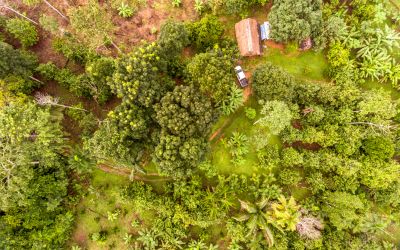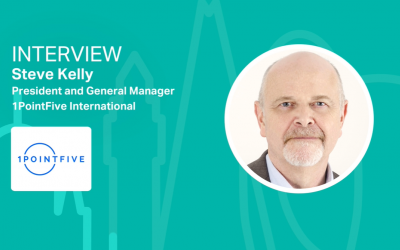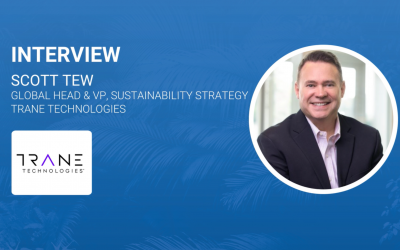Jay Zoellner on how businesses can benefit from the transition to a new flexible grid system
During the Energy Transition Summit, Climate Action spoke to Jay Zoellner, CEO at Kiwi Power, to discuss how businesses can benefit from the transition to a new flexible grid system.

During the Energy Transition Summit, Climate Action spoke to Jay Zoellner, CEO at Kiwi Power, to discuss how businesses can benefit from the transition to a new flexible grid system.
You’re speaking as part of our Roadmap to COP26 Energy transition summit. A lot of attention is being given to renewable energy capacity, but why is grid flexibility just as important in helping us achieve renewable energy targets?
Grid flexibility is the critical enabler to ensure we maximise renewable energy generation for two primary reasons. First, the grid must be constantly in balance between the supply of energy, and the demand for it, in real-time. Day and night, weather patterns all change how much renewable power is generated, without regard to the demand for it. Balancing the need for power with the availability of it at any moment of time, day or night and regardless of the weather at the moment is the challenge that the flexible grid solves for every second. The better we do this, the less we must rely on power available through the traditional generating sources of coal, natural gas and nuclear, all of which can be weather and time independent.
Second, we all understand money is the ultimate enabler of solutions and renewable energy targets are no exception. The flexible grid promotes sound renewable energy investment by enabling programmes that are responsive to price signals that are designed to be dependent upon capacity, availability, location, frequency, responsiveness, duration, etc. These price signals can be applied to be both the generation of power and to the use of power at any moment in time. As a result, we can use the renewable power more efficiently, which is an important element to maximising its funding.
Over the past year, the pandemic has necessitated a shift in priorities. How do you see the post-pandemic world playing out, in terms of the grid and energy technology? Are there lessons to be learnt from the past year about the role of flexible energy systems?
The pandemic demonstrated how quickly grid conditions can fundamentally change for a protracted period of time. Within the space of six weeks the UK found itself with an overabundance of renewable energy being produced (we saw a few 100% renewable settlement periods in the UK) and not enough demand on the grid to accommodate it. As a result, programme changes were needed to quickly address the matter and the National ESO rapidly introduced a new Optional Downward Flexibility Management service. Players in the energy space had to work very speedily to keep up.
It will be interesting to see how this will play out in the US, where there’s a bit of a rush to produce renewables and storage without considering the importance of grid flexibility. The best financial decision is going to lay in creating the right mix of energy sources, in the right locations where an iterative approach, enabled by the right energy flexibility technology (like Kiwi Core of course!), to make that transition.
In the developing world, availability and resilience are the priorities, further encumbered by the ubiquitous challenges of data inaccessibility, patchwork infrastructure and fuel source reliability all colluding to make it a daunting challenge to mount a coordinated response. Grid flexibility can help bridge many of these gaps, by utilising proven forms of communication and control for isolated and remote assets present in more established grid systems. The pandemic showed the entire world our ability to adapt rapidly is possible. Let’s apply these “change-lessons” to our approach to carbon emissions, as if it is our next pandemic, which could serve to catalyze the global transition to renewable energy. It is the perfect time.
Kiwi Power has a strong foundation in the UK and recently launched in the US. What makes this an attractive time to be entering into the US market?
Clearly, the Biden administration has big ambitions to change the sustainability landscape in the US. The federal government is already making efforts to support the transition to more renewables and a flexible grid.
In 2020, the U.S. Court of Appeals declared that states cannot opt out of the Federal Regulatory Commission’s (FERC) Order 841 provisions, meaning distributed energy storage can participate in wholesale energy markets with the backing of federal regulators. This provision has tremendous potential to enhance grid flexibility by allowing even the smallest energy assets (as small as 100 kW) to participate in the market.
There are 7 different grid operators in the USA with independent authority - and programmes, which they use to incentivise participants. To this point, the largest companies with the larger assets, in the right locations, have had the best opportunities to take advantage of the various distributed energy flexibility programmes. FERC Order 2222 allows all distributed energy resources, even behind regulated utility territories that are larger than the specified energy consumption level, to compete in all regional organized wholesale electric markets. This will further open the flexibility market for increased participation by all stakeholders in the energy transition.
There’s still a lot of work to be done on a number of fronts, as you can read in a more indepth article here. I am heartened by the rapid movement in the right direction.
Many companies are beginning to realise the potential of energy flexibility. Can you explain how businesses might contribute to, and benefit from, the transition to a new flexible grid system?
Many businesses own assets which have down-time that is unproductive, waiting to be utilised, costing money to maintain and use and / or doing very little when they are not being used. These could be solar panels, back-up generators, batteries and even energy consuming equipment such as large refrigeration compressor systems, air compressor systems, and air conditioning units.
Kiwi Power’s technology means that any of those assets can be quickly connected to the grid via our incredibly efficient and low-cost hardware, Kiwi Fruit, or through an application programme interface (API) and managed via Kiwi’s Virtual Power Plant (VPP) technology platform, Kiwi Core.
In very simple terms, we help you turn on and turn off your technology at the right times to help to manage the growing intermittency in our power supply from renewable sources and in response to changes in energy demand. This makes the grid much more resilient, whilst supporting you to bring in revenue and avoid costs through enabling participation in a number of different energy markets.
Ultimately, this allows for more penetration of renewables and low-carbon power sources, whilst democratising energy production so that business at large is empowered to play an active role in the transformation of our energy system to one that benefits the many, not the few.
Can you share what you think will be the three biggest challenges faced in this new energy transition?
Number one, without a doubt, is security. The recent example of Colonial Pipeline, a major US gas pipeline company that was closed down by cyber criminals, is the most recent case in point. We need to ensure that the flexible energy systems we are building are immune to attacks.
Number two is simplicity. Energy flexibility is a complex activity to coordinate considering the multitude and variability of programmes across many different transmission and distribution systems, which communicate with each other to remain balanced. Kiwi Power simplifies participation in energy flexibility markets and provides utilities and businesses the confidence to participate. Simplicity and confidence are critical to achieve the scale necessary to impact our carbon emissions. Today we see value shifting away from the supply of energy and toward the supply of energy flexibility; in other words realising cash by using your assets to participate in grid flexibility programmes with confidence. Kiwi Power has published a glossary which explains key terms associated with energy flexibility.
Local grid management is an emerging and soon to be enormous challenge; I am particularly thinking of the rapid growth anticipated in the electric vehicle market. Current global grids are not designed to absorb this amount of extra load, in a concentrated period of time in localised areas. Add the growth of solar generation behind the meter where the DSO or utility likely has no visibility or management control and we have ourselves a growing imbalance problem. These local grid management issues are an important focus for Kiwi Power’s biggest challenges and top priorities. Enabling the successful conversion to electric transport and local renewable generation by solving the visibility and control issue for utility and distributed network operators cost effectively will make a huge contribution toward reducing carbon emissions.
In every transition there are winners and there are losers. Who do you think will be the ‘winners’ and who will be the ‘losers’ of the flexible grid transition? How can we ensure those who stand to lose, don’t lose too much?
The winners will embrace energy flexibility quickly and completely. As a business, once you’re pointed in the right direction, it should become a central component of every energy management strategy. And as a grid operator, the shift in mindset is even more critical. Kiwi Power’s 10+ years of operating in the UK means we have been an active and important participant in the energy transition already, with the technology and expertise to solve these critical issues.
The losers are those potential customers with underutilised assets that are sitting there whilst their competitors realise more profit and cash by utilising their assets in energy flexibility markets. In one market programme we work with here in the UK, companies participating can realise £45,000 for each MW-year of assets made available to participate in grid flexibility.
DSR aggregation is at risk as a business model. Kiwi Power started its business as a DSR aggregator, and even today is one of the UK’s leading DSR aggregators, so we don’t consider this impact lightly. Nevertheless we have embraced this change as inevitable in the energy transition and our new customers and flexibility suppliers realise more value for themselves by the solutions we provide.
Of course that is also the case for those businesses who rely upon aggregators as their primary means to participate in energy flexibility. If a competitor utilises the solutions we offer as the new Kiwi Power, then they will be realising substantially more revenue than those sticking with the traditional aggregator business model.
Kiwi Power is sponsoring the Energy Transition Summit this week! You can still Register now to connect with key players in the energy sector to further drive this net-zero transition through policy and regulation, to innovation, technology and investment.






